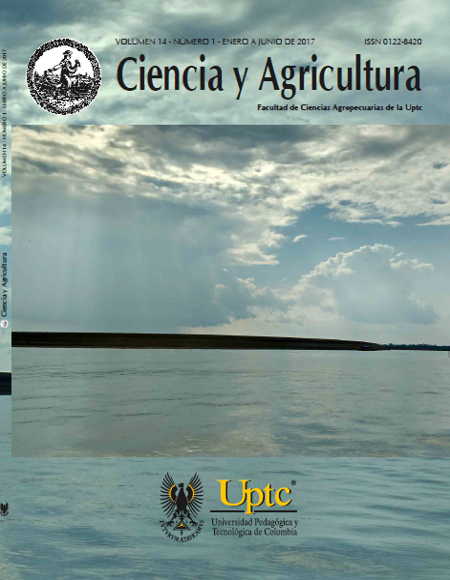Microbial preparation with lactic acid activity (lab) as biological accelerant in the fermentation process to feed cattle

Abstract
The objective of this study was to develop a microbial preparation, starting from an elaborated yogurt, based on a lactic acid bacteria (BAL) culture of medium and fast acidification, Lactobacillus de/brueckii ssp bu/garicus and Streptococcust hermophilus, from a commercial lyophilized culture (Liofast Y452B, SACCO ®). For the pH microbial preparation, an ANOVA analysis was carried out, by dividing the fermentation in 6 time intervals (O, 6, i2, 24, 36 and 48 hours) with three replicates. The inoculum preparation started from the elaboration of the yogurt, which was prepared with whole cow’s milk, heated to 45 °C, and inoculated with lactic acid bacteria culture. The final product showed a pH of 4.63 at 48 h, (p<0.0001); this product controlled the bacterial pathogens growth, and allowed a lactic acid bacteria final growth of 99x106 UFC/mL, to be used as microbial additive and as biological accelerator in fermentation processes, and possibly as a probiotic use for animal feed.
Keywords
inoculants, lactic acid bacteria, microbial additives, microbial preparations.
References
- Elías A, Herrera FR. Producción de alimentos para animales a través de procesos biotecnológicos sencillos con el empleo de microorganismos beneficiosos activados (MEBA). Rev. Cuban Journal of Agricultural Science. 2008; 41(1): 8-13.
- Díaz B, Elias A, Valiño E. Consorcios microbianos con actividad ácido-láctica promisoria aislados desde inoculantes bacterianos nativos para ensilajes. Rev. Ciencia y Agricultura. 2014; 11(1): 17-25. DOI: http://doi.org/10.19053/01228420.3484. DOI: https://doi.org/10.19053/01228420.3484
- Jay JM. Modern food microbiology, 6th edition. Aspen publication. Gaithersburg, Maryland, USA. 2000; 45-46. DOI: http://doi.org/10.1007/978-1-4615-4427-2. DOI: https://doi.org/10.1007/978-1-4615-4427-2
- FAO. Los Probióticos-Agentes beneficiosos para la salud. CERELA. Disponible en http://www.cerela.org.ar/ciencia/probioticos.htm. [Consultado en diciembre 2015]. 2001.
- Di Rienzo JA, Casanoves F, Balzarini MG, Gonzalez L, Tablada M, Robledo CW. InfoStat versión 2012. Grupo InfoStat, FCA, Universidad Nacional de Córdoba, Argentina. 2012.
- Azadnia P, Zamani MH, Shah G, Khalegh M, Karimi M, Taarof N. Isolation and identification of thermophilic Lactobacilli from tradicional yogurts of tribes of Kaserum. Journal of Animal and Veterinary Advances. 2011; 10: 774-776. DOI: http://doi.org/10.3923/javaa.2011.774.776. DOI: https://doi.org/10.3923/javaa.2011.774.776
- Vásquez S, Suárez H, Zapata S. Utilización de sustancias de sustancias antimicrobianas producidas por bacterias ácido lácticas en la conservación de la carne. Revista Chilena de Nutrición. 2009; 36: 64-71. DOI: https://doi.org/10.4067/S0717-75182009000100007
- Nkosi B, Meeskeb R. Effects of ensiling totally mixed potato hash ration with or without a heterofermentative bacterial inoculant on silage fermentation, aerobic stability, growth performance and digestibility in lambs. Animal Feed Science and Technology. 2010; 161: 38–48. DOI: http://doi.org/10.1016/j.anifeedsci.2010.07.015. DOI: https://doi.org/10.1016/j.anifeedsci.2010.07.015
- Requena T, Peláez C. Revisión: Actividad antimicrobiana de bacterias lácticas. Producción de bacteriocinas. Rev. Española Cienc. Tecnol. Alimentos. 1995; 35: 19-44.
- Avila FA, Paulillo AC, Schocken RP, Lucas FA, Orgaz A, Quintana J. A comparative study of the efficiency of a probiotic and the anti-K99 and anti-A14 vaccines in the control of diarrhea in calves in Brazil. Rev. Elev. Med. Vet. Pays. Trop. 1995; 48: 239-243. DOI: https://doi.org/10.19182/remvt.9450
- Rolfe R. The role of probiotic cultures in the control of gastroint. J Nutr. 2000; 130: 396-402. DOI: https://doi.org/10.1093/jn/130.2.396S
- González B, Gómez M, Jiménez Z. Bacteriocinas de probióticos. RESPYN. 2003; 4(2): 396-402.
- Auquilla R. Aprovechamiento biotecnológico de residuos agroindustriales para alimentación de rumiantes. Tesis de grado. ESPOCH. Riobamba, Ecuador. 2002.
- Veloz V. Evaluación de ensilaje de residuos agroindustriales en bovinos de carne. Tesis de grado. ESPOCH, Riobamba, Ecuador. 2004.
- Flores L, García Y, Proaño F, Caicedo W. Evaluación de tres dosis de un preparado microbiano, obtenido en Ecuador, en la respuesta productiva y sanitaria de cerdos en posdestete. Rev. Ciencia y Agricultura. 2015; 12(2): 59-70. DOI: http://doi.org/10.19053/01228420.4392. DOI: https://doi.org/10.19053/01228420.4392